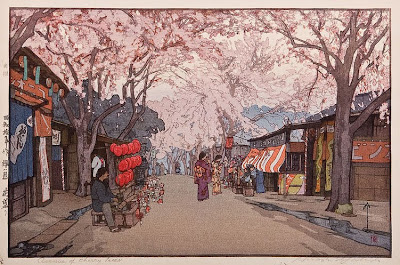
One of the great Japanese woodblock artists, Hiroshi Yoshida (1876-1950) was especially noted for his exquisitely detailed, evocative prints of landscapes around the world. His work is beautiful, subtle and often atmospheric, displaying a real mastery of his technique, which allowed him to capture the subtleties of light and form. Yoshida often reused the same woodblocks, varying the colours and saturation to suggest alternate moods of the same scene – a different time of day, or even different weather conditions.
Initially trained as a painter (of some renown), Yoshida began working with woodblocks in the early 1920s, and after a meeting with the owner of the Watanabe Print Store in Tokyo he had his first series of prints published. The woodblock technique is notoriously time-consuming and difficult, but Yoshida seemed able to capture the most delicate graduations of colour and the tiniest details in a temple façade or mountain face.
Yoshida was a keen traveller and visited numerous countries from the early 1900s onwards - his cosmopolitan attitude is reflected in the landscapes and studies he created in countries like India and America. The traditional Japanese techniques in his work applied to a changing foreign world at the beginning of the 20th Century make for some fascinating, unexpected images, which sit comfortably alongside his more elegiac landscapes. Whilst the world has changed almost immeasurably in the 50 or so years since Yoshida died, when viewed today, well-kept examples of his woodblocks still have a real vibrancy and warmth to them.
Yoshida died in 1950 but his two sons Toshi and Hodaka both became respected woodblock artists in their own right, carrying on the family tradtion. In fact, since the mid-1800s the same Yoshida family - Hiroshi's forebears - has produced eight artists of serious renown – a veritable woodblock dynasty.


+1925.jpg)























great
ReplyDelete